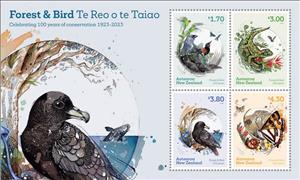Souvenir Sheet: Forest & Bird Conservation Program, Centenary (New Zealand 2023)
Forest & Bird Conservation Program, Centenary (New Zealand 2023)
05 April (New Zealand ) within release Forest & Bird Conservation Program, Centenary (2023) goes into circulation Souvenir Sheet Forest & Bird Conservation Program, Centenary face value 12.80 New Zealand dollar
| Souvenir Sheet Forest & Bird Conservation Program, Centenary in catalogues | |
|---|---|
| Colnect codes: | Col: NZ 2023.04.05-05 |
Souvenir Sheet is horizontal format.
Also in the issue Forest & Bird Conservation Program, Centenary (2023):
- Stamp - Black Petrel (Procellaria parkinsoni) face value 3.80;
- Souvenir Sheet - Forest & Bird Conservation Program, Centenary face value 12.80;
- Stamp - Forest Ringlet (Dodonidia helmsii) face value 4.30;
- Stamp - Lōkako, Tīeke, Kākāriki and Tūī Birds face value 1.70;
- Stamp - Tautuku Gecko (Mokopirirakau sp.) face value 3.00;
Souvenir Sheet Forest & Bird Conservation Program, Centenary it reflects the thematic directions:
Birds (Aves), a subgroup of Reptiles, are the last living examples of Dinosaurs. They are a group of endothermic vertebrates, characterised by feathers, toothless beaked jaws, the laying of hard-shelled eggs, a high metabolic rate, a four-chambered heart, and a strong yet lightweight skeleton. Birds live worldwide and range in size from the 5 cm (2 in) bee hummingbird to the 2.75 m (9 ft) ostrich. They rank as the class of tetrapods with the most living species, at approximately ten thousand, with more than half of these being passerines, sometimes known as perching birds. Birds are the closest living relatives of crocodilians.
Butterflies are insects in the macrolepidopteran clade Rhopalocera from the order Lepidoptera, which also includes moths. Adult butterflies have large, often brightly coloured wings, and conspicuous, fluttering flight. The group comprises the large superfamily Papilionoidea, which contains at least one former group, the skippers (formerly the superfamily "Hesperioidea") and the most recent analyses suggest it also contains the moth-butterflies (formerly the superfamily "Hedyloidea"). Butterfly fossils date to the Paleocene, which was about 56 million years ago. Butterflies have the typical four-stage insect life cycle. Winged adults lay eggs on the food plant on which their larvae, known as caterpillars, will feed. The caterpillars grow, sometimes very rapidly, and when fully developed, pupate in a chrysalis. When metamorphosis is complete, the pupal skin splits, the adult insect climbs out, and after its wings have expanded and dried, it flies off. Some butterflies, especially in the tropics, have several generations in a year, while others have a single generation, and a few in cold locations may take several years to pass through their whole life cycle. Butterflies are often polymorphic, and many species make use of camouflage, mimicry and aposematism to evade their predators. Some, like the monarch and the painted lady, migrate over long distances. Many butterflies are attacked by parasites or parasitoids, including wasps, protozoans, flies, and other invertebrates, or are preyed upon by other organisms. Some species are pests because in their larval stages they can damage domestic crops or trees; other species are agents of pollination of some plants. Larvae of a few butterflies (e.g., harvesters) eat harmful insects, and a few are predators of ants, while others live as mutualists in association with ants. Culturally, butterflies are a popular motif in the visual and literary arts.
Environmental protection is the practice of protecting the natural environment by individuals, groups and governments.Its objectives are to conserve natural resources and the existing natural environment and, where it is possible, to repair damage and reverse trends.



